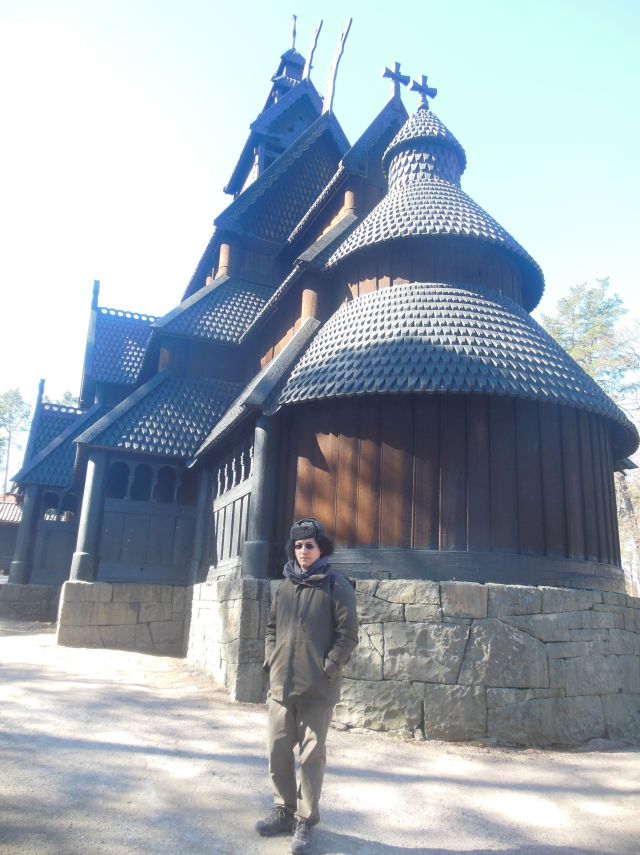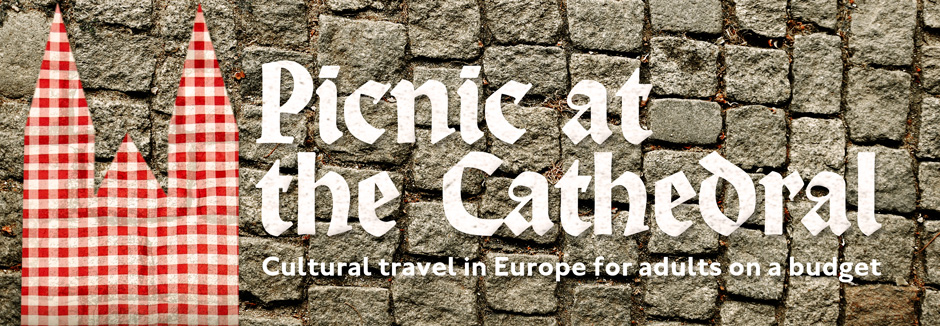Vikings are popular these days, but please don’t invite me to that party. As far as I’m concerned, being a fan of Vikings is akin to being a fan of Isis. Like Isis, Vikings destroyed priceless works of cultural heritage (and yeah, they killed a lot of people too). I’m taking the side of the creators, not the destroyers.
Of course I know that Vikings did, in fact, create objects that could be described as art. Certainly some were accomplished woodcarvers and boat builders. While we were in Norway, I made an effort to appreciate Viking art on its own terms.

I mean I really tried, but even after all that effort my favorite part about the Viking Ship Museum was meeting these cheeky Norwegian boys who insisted I take their picture and then attempted to convince me that they were from Japan.

We also visited Oslo’s Historical Museum to see the Viking exhibit. While there were a few moderately interesting Viking-made artifacts, the major portion of the show consisted of treasures that had been looted by Vikings from other cultures.

It wasn’t until we visited the Gol Stave church that I could begin to engage in the Viking artistic heritage, because I saw an influence of Viking art on the church’s design.

The Gol church was the only stave church we visited in Norway—naturally I had planned to visit as many as possible, only to realize that all stave churches are closed during off season, with the exception of Gol. This church is part of Oslo’s outdoor Norwegian Folk Museum. The original, c. 1200, was moved and reconstructed from another location, so I think of it as a stave in captivity.

Here is the Oseberg ship, c. 800, from the Viking Ship Museum. There’s something about the curvilinear elegance of the ship’s prow that is recalled in the Gol church’s roof chapels and the flamboyant wood carvings projecting from the gables.

(I didn’t meet any cheeky boys who wanted me to take their picture at the Gol church, but there was this one hot dude…)
The resemblance between the Viking art and the stave church is also quite apparent in the decorative details. On the left is a bit carving on the Oseberg ship and on the right is a detail of the décor next to the Gol church door.
These winners of the Norwegian Facial Hair Lifetime Achievement Award are from a Viking wagon (left) and the Gol Church (right).
I guess there’s nothing too shocking about these similarities—the Viking age extended to 1066 so it makes sense that their artifacts would have influenced, or have even been incorporated, into early stave churches.
What I didn’t expect was to see the Viking art motifs so obviously reflected in the furnishings of the Norwegian Art Nouveau movement. Here are some details from a chair and chest drawer in Ålesund’s Art Nouveau museum next to that detail from the Oseberg ship. Like, isn’t the whole point of Art Nouveau to be new? It must have nationalism that compelled Norwegian artisans of the early 20th century to look back with nostalgia to a more barbaric age.
Yeah, I deliberately used the word barbaric, though I realize it could be misinterpreted. I don’t mean barbaric to imply pagan (paganism is a party I want to be invited to). I mean barbaric as destructive of human values—Viking sacking monasteries, Christians on crusades, and a US presidential administration that locks up migrant children in unsafe ersatz prisons—-when a culture embraces cruelty, I can try to appreciate its artifacts, but it sure as hell isn’t getting my affection.
Give me a stave in captivity any day.

How we got to Ålesund: bus from Trondheim.
Where we slept: City View Studio Apartment. Price: €92 for a double. Recommended: yes.
How we got to Olso: bus from Ålesund to Åndalsnes, train from Åndalsnes to Dombås, and another train from Dombås to Oslo.
Where we slept: Citybox Oslo. Price: €83 for a double. Recommended: yes.









The Oseberg style lasted most of the 9th century and appears in some Viking religious iconography. Its main feature is the gripping beast motif and sinuous animal forms. Paws grip borders, the neck of the creature, other creatures or other parts of its body. The gripping beast must have echoed something in the culture of Viking art as it stood fast for a good 150 years.
LikeLiked by 1 person
Thanks for this fascinating info, Mysterious Blogger! Do the gripping, sinuous beasts remind you of Romanesque art?
LikeLiked by 1 person
Yes! Fantastic beasts were a frequent subject in Romanesque art: some lithe and supple. The same can be said for many Playboy centerfolds.
LikeLiked by 1 person
LOL!
LikeLiked by 1 person
I’m with you on all counts. And you guys are adorable. Relationship goals for my next life!
LikeLiked by 1 person
Thanks! You’re only thinking relationship goals because I left out the parts where I get hangry and yell at HOB because he’s so slow…
LikeLiked by 1 person
With you.
LikeLiked by 1 person
Thank you, glad I’m not the only one who doesn’t idolize the dark age monastery raiders. Think of all those manuscripts destroyed!
LikeLiked by 1 person
I didn’t know Oslo had a stave church! As for Vikings, we Minnesotans like to rationalize that our Scandinavian ancestors were more settlers and farmers than raiders and pillagers. I was mesmerized by the Oseberg ship and the others there, conveniently ignoring the violence, I guess. Interestingly, during the time the Danes actually ruled England, they took pains to portray themselves as reasonable fellows willing to sit in rows and listen to their leaders. I saw a cool Art-Nouveau mural about that at Frederiksborg.
LikeLiked by 1 person
Those in power always promote their own image….
LikeLiked by 1 person
Well, my ancestors may well have been slave traders, so perhaps that’s as bad or worse than raiders and pillagers. Now that I’m in the habit of visiting expensive Scandinavian countries I might I well go to Frederiksborg to see that cool mural for myself.
LikeLiked by 1 person
Wow, I had no idea about those types of churches!
LikeLiked by 1 person
Look at this one in Borgund—-I really want to see it! http://www.stavechurch.com/borgund-stave-churc/?lang=en
LikeLiked by 1 person
The stave church is truly wonderful. I find the Viking art you showed to be very reminiscent of Celtic art. Were the Celts influenced by the Vikings? My how good ideas travel.
LikeLiked by 1 person
Yes, there are a lot of similarities. I wish I knew more about Celtic art—good excuse for another trip!
LikeLike
Oooh the Oslo Stave Church!!! Did you see the graffiti scribbled in runic on the wooden pews and columns inside?
LikeLiked by 1 person
Gah, how did I miss that!?!?!? Do you have a picture of it?
LikeLike
Not a photo but a link: http://norwayroadways.blogspot.com/2014/04/borgund-stave-church-gallery-runes.html?m=1
LikeLike
Very cool.
LikeLiked by 1 person
Thanks! Our next trip will be a place you recently visited as well. Your posts were quite inspiring!
LikeLiked by 1 person
I await with suspense for your next post!
LikeLiked by 1 person